Session 6 Li Chusi Evolution of Genetic Models for Magmatic Ni-Cu Sulfide Deposit 岩浆硫化物矿床成因
系统与进化生物学名词解释完整版

第一章:绪论进化生物学Evolutionary Biology:是研究生物进化的科学,不仅研究进化的过程,更重要的是研究进化的原因、机制、速率和方向。
(研究生物进化的科学,包括进化的过程、证据、原因、规律、演说以及生物工程进化与地球的关系等。
)系统学Taxonomy:is the science of defining groups of biological organisms on the basis of shared characteristics and giving names to those groups.根据生物体显现出的的基本特征定义并确定其群体名称的学科。
系统生物学Systematic Biology:研究生物系统组成成分的构成与相互关系的结构、动态与发生,以系统论和实验、计算方法整合研究为特征的生物学。
系统与进化生物学Systematic and Evolutionary Biology:分类Classification:provide a convenient method of identification and communication.为生物的辨识与交流提供更便捷方法的学科。
系统发育Phylogeny:the evolutionary relationships among a group of species,provide a classification which as far as possible expresses the natural relationships of organism.研究种群之间进化的联系,尽可能地为解读生物体之间的自然关系提供一种分类方式的科学。
进化Evolution:detect evolution at work,discovering its processes and interpreting its results.(PPT)进化指食物由低级的、简单的形式向高级的、复杂的形式转变过程。
基因表达 细胞特异和物种演化
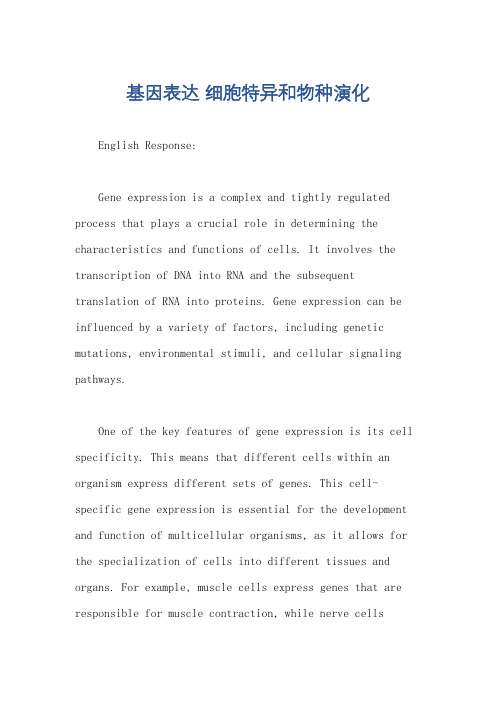
基因表达细胞特异和物种演化English Response:Gene expression is a complex and tightly regulated process that plays a crucial role in determining the characteristics and functions of cells. It involves the transcription of DNA into RNA and the subsequent translation of RNA into proteins. Gene expression can be influenced by a variety of factors, including genetic mutations, environmental stimuli, and cellular signaling pathways.One of the key features of gene expression is its cell specificity. This means that different cells within an organism express different sets of genes. This cell-specific gene expression is essential for the development and function of multicellular organisms, as it allows for the specialization of cells into different tissues and organs. For example, muscle cells express genes that are responsible for muscle contraction, while nerve cellsexpress genes that are involved in transmitting electrical signals.The cell specificity of gene expression is achieved through a variety of mechanisms. One important mechanism is the presence of tissue-specific transcription factors. These transcription factors are proteins that bind to specific DNA sequences and either promote or repress the transcription of genes. For example, the transcriptionfactor MyoD is essential for the expression of muscle-specific genes in muscle cells.Another mechanism that contributes to cell-specificgene expression is epigenetic modifications. These modifications are chemical changes to DNA or histones that can alter the accessibility of DNA to transcription factors. For example, DNA methylation is a type of epigenetic modification that can repress gene expression by blockingthe binding of transcription factors to DNA.In addition to cell specificity, gene expression isalso subject to species evolution. Over time, changes inthe DNA sequence of genes can lead to changes in gene expression. These changes can have a variety of effects, including alterations in the function of cells, the development of new traits, and the evolution of new species. For example, changes in the expression of genes involved in beak morphology have been linked to the evolution ofdifferent beak shapes in Darwin's finches.The study of gene expression is a rapidly growing field of research. Advances in molecular biology techniques have made it possible to identify and characterize the genesthat are expressed in different cells and tissues. This research has provided valuable insights into the development and function of multicellular organisms and has also helped to elucidate the mechanisms of evolution.Chinese Response:基因表达是一个复杂且受严格调控的过程,在决定细胞的特征和功能方面起着至关重要的作用。
生物专业外语笔试题目及答案
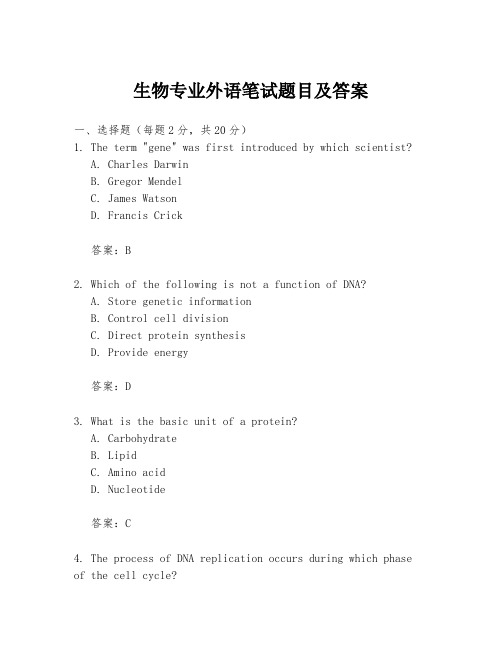
生物专业外语笔试题目及答案一、选择题(每题2分,共20分)1. The term "gene" was first introduced by which scientist?A. Charles DarwinB. Gregor MendelC. James WatsonD. Francis Crick答案:B2. Which of the following is not a function of DNA?A. Store genetic informationB. Control cell divisionC. Direct protein synthesisD. Provide energy答案:D3. What is the basic unit of a protein?A. CarbohydrateB. LipidC. Amino acidD. Nucleotide答案:C4. The process of DNA replication occurs during which phase of the cell cycle?A. G1 phaseB. S phaseC. G2 phaseD. M phase答案:B5. Which of the following is a type of genetic mutation?A. TranscriptionB. TranslationC. TransversionD. Translocation答案:C二、填空题(每空2分,共20分)6. The central dogma of molecular biology states that genetic information flows from DNA to RNA and then to _______.答案:protein7. In eukaryotic cells, the process of protein synthesis takes place in the _______.答案:cytoplasm8. The term "genome" refers to all the genetic material of an _______.答案:organism9. The process by which a fertilized egg develops into afully formed individual is known as _______.答案:development10. The study of the relationships among various species is known as _______.答案:taxonomy三、简答题(每题10分,共40分)11. Briefly describe the structure of a typical eukaryotic cell.答案:A typical eukaryotic cell has a nucleus that contains the genetic material, a cell membrane that encloses the cell, cytoplasm where organelles such as mitochondria, endoplasmic reticulum, and Golgi apparatus perform various functions, and other structures like lysosomes and a cytoskeleton.12. Explain the concept of natural selection and its importance in evolution.答案:Natural selection is the process by which individuals with traits that are better suited to their environment are more likely to survive and reproduce, passing on those advantageous traits to their offspring. It is a key mechanism of evolution, leading to adaptation and the diversity of life forms.13. What are the main differences between prokaryotic and eukaryotic cells?答案:Prokaryotic cells lack a nucleus and membrane-bound organelles, whereas eukaryotic cells have a defined nucleus and various membrane-bound organelles such as mitochondria and the endoplasmic reticulum. Prokaryotes are generally smaller and simpler in structure compared to eukaryotes.14. Describe the process of photosynthesis and its significance for life on Earth.答案:Photosynthesis is the process by which green plants and some other organisms convert light energy into chemical energy stored in glucose or other organic molecules. It is significant for life on Earth as it provides oxygen and is the primary source of energy for most food chains.四、论述题(每题20分,共20分)15. Discuss the impact of genetic engineering on modern agriculture and medicine.答案:Genetic engineering has revolutionized agriculture by enabling the development of crops with improved resistance to pests and diseases, better tolerance to environmental stresses, and enhanced nutritional content. In medicine, it has facilitated the production of recombinant proteins and vaccines, the development of gene therapies, and the advancement of personalized medicine based on genetic profiles.结束语:本试题旨在考察学生对生物专业外语知识的掌握程度以及应用能力,希望同学们能够通过本试题加深对生物学基本概念和原理的理解,并在实际应用中不断进步。
从DNA序列到分化时间——进化树与分子钟
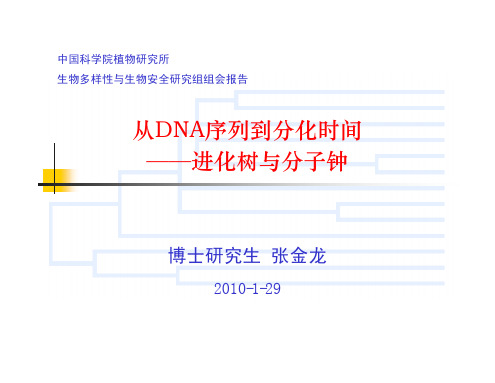
从DNA序列到分化时间 ——进化树与分子钟
博士研究生 张金龙
2010-1-29
报告内容
一 DNA序列 二 序列比对 三 碱基替换模型及其筛选 四 进化树的构建 五 树的可信度 Bootstrap 六 分子钟
2010-1-29
从DNA序列到分化时间
从DNA序列到分化时间 24
碱基替换模型
n n
General Time Reversible model (GTR) 是所有碱基替换模型中考虑参数最多的,之前的 模型都可以看做GTR模型的特例。 实际的碱基比例是不等的(两两之间),两两之 间的替换率也是不等的,而所有这些参数的均已 经以整合到GTR模型中。
n物种数, t进化树的数目
2010-1-29 从DNA序列到分化时间 34
n
进化树数量随物种数增加的变化 自 A.Stamatakis 2007
从DNA序列到分化时间 35
2010-1-29
建立进化树的软件
n n n n n n
PHYLIP 距离法、极大似然法等 PAUP* 最大简约法、极大似然法、距离法等 MrBayes 贝叶斯法 PHYML 极大似然法(大样本量) RAMxL 极大似然法 (大样本量) MEGA 距离法、极大似然法等
从DNA序列到分化时间 4
2010-1-29
3. 各种进化树 (自N. Nikolaidis)
2010-1-29 从DNA序列到分化时间 5
一 DNA序列
DNA序列
n n n n n n
由ATCG四个碱基组成,一般从其3’端作为起始。 一个基因的长度在几百到几千个bp(碱基对)不等。 现有的序列可在NCBI 检索,下载。 NCBI National Center for Biotechnology Information
别构酶的序变模型及齐变模型名词解释

别构酶的序变模型及齐变模型名词解释下载提示:该文档是本店铺精心编制而成的,希望大家下载后,能够帮助大家解决实际问题。
文档下载后可定制修改,请根据实际需要进行调整和使用,谢谢!本店铺为大家提供各种类型的实用资料,如教育随笔、日记赏析、句子摘抄、古诗大全、经典美文、话题作文、工作总结、词语解析、文案摘录、其他资料等等,想了解不同资料格式和写法,敬请关注!Download tips: This document is carefully compiled by this editor. I hope that after you download it, it can help you solve practical problems. The document can be customized and modified after downloading, please adjust and use it according to actual needs, thank you! In addition, this shop provides you with various types of practical materials, such as educational essays, diary appreciation, sentence excerpts, ancient poems, classic articles, topic composition, work summary, word parsing, copy excerpts, other materials and so on, want to know different data formats and writing methods, please pay attention!别构酶,也被称为调节酶,是生物体内一类通过非共价键作用,对底物进行特异性构象改变的酶。
encyclopedia of dna element -回复

encyclopedia of dna element -回复Encyclopedia of DNA Elements (ENCODE): Decoding the Blueprint of LifeIntroduction:The Encyclopedia of DNA Elements, also known as ENCODE, is an international research initiative aimed at identifying and characterizing all functional elements in the human genome. This groundbreaking project provides a comprehensive catalog of the elements that regulate gene expression, chromatin organization, and DNA transcription and replication. In this article, we will delve into the ENCODE project, discuss its significance, and explore the intricacies of DNA elements.I. Unraveling the Human Blueprint:The human genome consists of approximately three billion base pairs of DNA, which contain the instructions for building and operating a human being. However, only a fraction of this genetic material, around 2, directly codes for proteins. The remaining portion, once regarded as so-called "junk DNA," has since proven to hold vital functional elements. ENCODE seeks to uncover and understand the role of these non-coding elements in generegulation and cellular processes.II. Cataloging Functional Elements:The ENCODE project utilizes advanced molecular biology techniques and high-throughput sequencing to map and identify various DNA elements across the human genome. The catalog of elements includes protein-coding genes, non-coding RNA genes, transcription factor binding sites, enhancers, promoters, insulators, and more. These elements work in concert to regulate gene expression, ensuring the proper functioning and development of cells and tissues.III. Decoding the Regulatory Grammar:One of the key objectives of ENCODE is to decipher the regulatory grammar encoded in our DNA. This involves understanding the complex network of interactions between DNA elements and their associated proteins. For example, enhancers are DNA regions that can significantly increase the expression of specific genes. Determining the specific enhancers for each gene is critical to comprehending their regulation accurately.IV. Functional Annotation of the Genome:ENCODE not only identifies DNA elements but also assigns functional annotations to them. Through careful experimentation and analysis, researchers can determine the function and importance of each element in various biological processes. This knowledge is invaluable for understanding human development, disease mechanisms, and potential therapeutic targets.V. Insights into Disease and Evolution:The ENCODE project provides valuable insights into the genetic basis of human diseases. By identifying disease-associated genetic variants within functional DNA elements, researchers can elucidate the mechanisms underlying diseases such as cancer, diabetes, and neurological disorders. Furthermore, comparative genomics studies utilizing ENCODE data help elucidate the evolutionary changes in DNA elements that have shaped human diversity.VI. Open Science and Collaborative Efforts:ENCODE follows an open science model, making its data and findings freely available to the scientific community. This approach fosters collaboration among experts worldwide, encouraging knowledge sharing and interdisciplinary research. The accessibility of ENCODE data empowers researchers to investigate their specificinterests within the vast realm of DNA elements.VII. Future Directions:While ENCODE has made significant progress since its initiation in 2003, there is still much to uncover. Future efforts will involve expanding the catalog of DNA elements in other organisms to achieve a comprehensive understanding of the functional components of genomes. Additionally, integrating ENCODE data with other large-scale biological datasets may lead to breakthroughs in precision medicine and personalized therapies.Conclusion:The Encyclopedia of DNA Elements, or ENCODE, is an ambitious project that has revolutionized our understanding of genetic regulation and gene expression. By cataloging and annotating functional elements within the human genome, ENCODE has provided unparalleled insights into disease mechanisms, evolutionary biology, and human development. As the project continues to unravel the complexities of DNA elements, it promises to shape the future of genomics and drive biomedical researchtowards new frontiers.。
植物学专有名词

前沿·热点Research Hot/Frontiers种系发生Phylogeny生命起源Origins of Life群落多样性Community diversity生物多样性Biodiversity外来物种Alien species物种共存Species coexistence生态系统健康Ecosystem HealthDNA条形码DNA barcoding信号转导Signal transduction细胞周期调控Cell cycle regulation细胞增殖cell proliferation细胞凋亡Cell Apoptosis生物钟Biological clock生物适应性Biochemical adaptation网络生物学Network biology生物控制论Biological Cybernetics染色体重排Chromosomal rearrangements 进化论The theory of evolution自然选择natural selection人工选择artificial selection细胞分裂cell division选择育种selective breeding遗传漂变Genetic drift种系发生phylogeny脱氧核糖核酸DNA生命起源Origin of life古生物学paleontology种系遗传学phylogenetics表型学phenetics共同祖先common descent物种形成Speciation古生菌archaea灵长类primates板块构造论plate tectonics无树大草原savannah寄生parasitism共生symbiosis生命之树Tree of life遗传分类学cladistics开放系统open system动态平衡dynamic equilibrium查尔斯·达尔文Charles Darwin动物Animals植物plants真菌fungi原生生物protists细菌bacteria原核生物prokaryote昆虫类insects病毒viruses多细胞生物multicellular organism热血动物warm-blood生态系统ecosystems系统发生树Phylogenetic tree新陈代谢metabolism遗传学Genetics遗传heredity变异variation核苷酸nucleotides氨基酸amino acids遗传密码genetic code泛生论pangenesis染色体chromosomes遗传连锁genetic linkage螺旋结构helical structure信使RNAmessenger RNA氨基酸序列amino acid sequence遗传的特征 Features of inheritance孟德尔Gregor Mendel等位基因alleles纯合子homozygote杂合子heterozygote基因型genotype表现型phenotype显性dominance隐性recessiveness不完全显性incomplete dominance共显性codominance有性繁殖sexual reproduction谱系图pedigree charts异位显性epistasis遗传力heritability遗传的分子基础 Molecular basis for inheritance 腺嘌呤adenine胞嘧啶cytosine鸟嘌呤guanine胸腺嘧啶thymine双螺旋double helix碱基对base pairs染色质chromatin核小体nucleosomes组蛋白histone单倍体haploid二倍体diploid性连锁遗传病sex-linked disorder无性生殖asexual reproduction有丝分裂mitosis配子gametes生殖细胞germ cells连锁图linkage map分子生物学中心法则central dogma of molecular biology 镰状细胞性贫血sickle-cell anemia核糖体RNArRNA转移核糖核酸tRNA微RNAmicroRNA苯(丙)酮尿症phenylketonuria转录因子Transcription factors大肠杆菌Escherichia coli色氨酸tryptophan负反馈negative feedback阻遏物repressor胞间信号intercellular signals副突变paramutation遗传改变Genetic change诱变mutagenesis紫外辐射UV radiationDNA修复DNA repair减数分裂meiosis适合度fitness果蝇Drosophila群体遗传学Population genetics适应adaptation分子钟molecular clock进化树evolutionary trees模式生物model organisms医学遗传学Medical genetics孟德尔随机化Mendelian randomization同源基因orthologues药物遗传学pharmacogenetics连接酶ligase分子克隆molecular cloning重组DNArecombinant DNA遗传多样性genetic diversity生物量biomass分子生物学Molecular biology分子筛molecular sieve核糖核酸RNA蛋白质的生物合成protein biosynthesis 生物大分子biomolecules复制replication翻译translation转录transcription克隆clone聚合酶链式反应PCR质粒plasmid载体vector启动子元件promoter elements抗生素耐性antibiotic resistance结合conjugation转导transduction转染transfection电穿孔electroporation显微注射microinjection三级结构tertiary structure定量多聚酶链反应QPCR电泳electrophoresis毛细管作用capillary action胚胎干细胞株embryonic stem cell lines SDS-PAGEnorthern blot放射自显影autoradiography增强子Enhancer抗体antibody蔗糖梯度sucrose gradient粘度测定法viscometry保护生物学Conservation biology生物多样性biodiversity种群动态population dynamics稀有种rare species自然保护运动conservation movement 灭绝extinction脊椎动物vertebrates无脊椎动物invertebrates人口过剩overpopulation砍伐森林deforestation放牧过度overgrazing刀耕火种法slash and burn应用生态学Applied ecology濒危物种Endangered species环境保护论Environmentalism迁地保护Ex-situ conservation基因污染Genetic pollution就地保护In situ conservation发育生物学Developmental Biology细胞生长cell growth形态发生morphogenesis分化differentiation染色体畸变chromosomal aberrations个体发生ontogeny细胞凋亡apoptosis先天性疾病congenital disorders内稳态homeostasis神经胚形成neurulation胚胎发生embryogenesis性别决定sex determination原肠胚形成gastrulation适应能力adaptive capacity衰老senescence细胞信号传导Cell signaling信号转导Signal transduction器官发生organogenesis胚胎发生embryogenesis形态发生morphogenesis生态学Ecology次级生产力secondary productivity捕食predationecozones食物链food chains大气圈atmosphere生物群落biocoenosis分解者Decomposers互利共生mutualism光合作用photosynthesis初级生产者primary producers初级消费者primary consumers三级消费者tertiary consumers食肉动物carnivores杂食动物omnivores生境biotope生物地球化学循环biogeochemical cycle氮循环nitrogen cycle陆地生态系统terrestrial ecosystems森林生态系统forest ecosystems水圈hydrosphere生物圈biosphere岩石圈lithosphere生态位ecological niche海洋生态系统marine ecosystems生态危机Ecological crisis血亲consanguinity植物学Botany/Plant Biology(Plant Science)真菌类fungi被子植物angiosperms藻类algae双子叶植物dicotyledon单子叶植物monocot裸子植物gymnosperm分类学taxonomy形态学morphology藓类Mosses苔类liverworts园艺学Horticulture花粉Pollen植物病理学Phytopathology植物生理学Plant physiology草本植物Herbs温室气体greenhouse gas地衣类lichens水循环water cycle古植物学家Paleobotanists果菜类fruit vegetable食性层次trophic level食品安全food security作物育种plant breeding人类植物学Ethnobotany遗传学定律genetic laws四氢大麻酚tetrahydrocannabinol跳跃基因jumping genes细胞生物学Cell biology显微镜microscope核糖体ribosomes细胞质cytoplasm膜蛋白membrane proteins内质网endoplasmic reticulum高尔基体Golgi apparatus细胞骨架cytoskeletal线粒体mitochondria细胞核nucleus叶绿体chloroplasts溶酶体lysosomes主动运输Active transportmRNA剪接mRNA splicing自吞噬Autophagy纤毛Cilia微管microtubule鞭毛Flagella脂质双层Lipid bilayerImmunostaining原位杂交In situ hybridization免疫沉淀反应Immunoprecipitation免疫组化immunohistochemistry生命周期life cycles神经生物学Neurobiology计算神经科学computational neuroscience 认知神经科学cognitive neuroscience行为神经学behavioral neuroscience生物精神病学biological psychiatry神经病学neurology神经心理学neuropsychology神经心理学neuropsychology树状突dendrites光受体photoreceptors动作电位action potentialsquid giant axon突触synapses神经系统nervous system多巴胺Dopamine去甲肾上腺素Norepinephrine肾上腺素Epinephrine黑色素Melanin神经递质neurotransmitters褪黑激素MelatoninP物质Substance P兴奋性突触后电位EPSP抑制性突触后电位IPSP神经元neuron听力系统auditory system嗅觉系统olfactory system视觉系统visual system胶质细胞glial cell神经板neural plate系统生物学Systems BiologyDNA微阵列DNA microarrays蛋白质组学Proteomics质谱测定法mass spectrometry高性能液体色谱HPLC phosphoproteomics糖蛋白质组学glycoproteomics代谢物组学Metabolomics Biomicsprocess calculi信息提取information extraction转录组学transcriptomics代谢组学metabolomics酶动力学enzyme kinetics糖组学Glycomics生物学的其他学科Other fields太空生物学Astrobiology微生物学Microbiology古生物学Paleontology寄生虫学Parasitology生理学Physiology动物学Zoology。
Mega6_ molecular evolutionary genetics analysis version 6.0

MBEBrief CommunicationMEGA6: Molecular Evolutionary Genetics Analysis version 6.0Koichiro Tamura 1, 2, Glen Stecher 3, Daniel Peterson 3, Alan Filipski 3, and Sudhir Kumar 3,4,5*1Research Center for Genomics and Bioinformatics, Tokyo Metropolitan University, Hachioji, Tokyo, Japan 2 Department of Biological Sciences, Tokyo Metropolitan University, Hachioji, Tokyo, Japan3Center for Evolutionary Medicine and Informatics, Biodesign Institute, Arizona State University, Tempe, Arizona, USA4School of Life Sciences, Arizona State University, Tempe, Arizona, USA5Center of Excellence in Genomic Medicine Research, King Abdulaziz University, Jeddah, Saudi Arabia*Correspondence to:Sudhir Kumar, Ph.D.Center for Evolutionary Medicine and InformaticsBiodesign Institute @ Arizona State UniversityTempe, Arizona 85287, USAEmail: s.kumar@© The Author 2013. Published by Oxford University Press on behalf of the Society for Molecular Biology and Evolution. All rights reserved. For permissions, please e-mail: journals.permissions@MBE Advance Access published October 16, 2013 at China Agricultural University on September 22, 2014/Downloaded fromAbstractWe announce the release of an advanced version of the Molecular Evolutionary Genetics Analysis (MEGA) software, which currently contains facilities for building sequence alignments, inferring phylogenetic histories, and conducting molecular evolutionary analysis. In version 6.0, MEGA now enables the inference of timetrees, as it implements our RelTime method for estimating divergence times for all branching points in a phylogeny. A new Timetree Wizard in MEGA6 facilitates this timetree inference by providing a graphical user interface (GUI) to specify the phylogeny and calibration constraints step-by-step. This version also contains enhanced algorithms to search for the optimal trees under evolutionary criteria and implements a more advanced memory management that can double the size of sequence data sets to which MEGA can be applied. Both GUI and command-line versions of MEGA6 can be downloaded from free of charge.at China Agricultural University on September 22, 2014/Downloaded fromThe Molecular Evolutionary Genetics Analysis (MEGA) software is developed for comparative analyses of DNA and protein sequences that are aimed at inferring the molecular evolutionary patterns of genes, genomes, and species over time (Kumar, et al. 1994; Tamura, et al. 2011). MEGA is currently distributed in two editions: a graphical user interface (GUI) edition with visual tools for exploration of data and analysis results (Tamura, et al. 2011) and a command line edition (MEGA-CC) which is optimized for iterative and integrated pipeline analyses (Kumar, et al. 2012).In version 6.0, we have now added facilities for building molecular evolutionary trees scaled to time (timetrees), which are clearly needed by scientists as an increasing number of studies are reporting divergence times for species, strains, and duplicated genes (e.g., Kumar and Hedges 2011; Ward, et al. 2013). For this purpose, we have implemented the RelTime method, which can be used for large numbers of sequences that comprise contemporary datasets, is the fastest method among its peers, and is shown to perform well in computer simulations (Tamura, et al. 2012). RelTime produces estimates of relative times of divergence for all branching points (nodes) in any phylogenetic tree without requiring knowledge of the distribution of the lineage rate variation and without using clock calibrations and associated distributions. Relative time estimates produced by MEGA will be useful for determining the ordering andspacing of sequence divergence events in species and gene family trees. In fact, the (relative) branch rates produced by RelTime will enable users to determine the statistical distribution of evolutionary rates among lineages and detect rate differences between species and duplicated gene clades. In addition, relative times obtained using molecular data can be directly compared with the times from non-molecular data (e.g., fossil record) to test independent biological hypotheses. The RelTime computation in MEGA6 is highly efficient in terms of both performance and memory required. For a nucleotide alignment of 765 sequences and 2,000 base pairs (data from Tamura, et al. 2011), MEGA6 required just 43 minutes and 1 gigabyte of memory (including the calculation steps mentioned below). Both time and memory requirements increase linearly with the number of sequences in MEGA6 (Figure 1). Figure 2shows a timetree produced by MEGA6 and displayed in the Tree Explorer, which has been upgraded from previous versions of MEGA to display confidence intervals and to export relative divergence times and evolutionary rates for branches, along with absolute divergence times and confidence intervals (see below). The Tree Explorer also allows customization of the timetree display in many ways for producing publication quality images.Using calibrations to translate relative times to absolute times.The relative times produced by the RelTime method can be directly converted into absolute times when a single known divergence time at China Agricultural University on September 22, 2014 / Downloaded from(calibration point) based on fossil or other information is available. This facility is incorporated in MEGA6 where a global time factor (f), which is computed from the given calibration point, converts all estimates of relative times (NT s) to absolute times (AT s) where AT x = f×NT x for the internal node x. This approach is taken because NT s are already shown to be linearly related with the true time (Tamura, et al. 2012). However, researchers often use multiple calibration points along with information on upper and/or lower bounds on one or more calibration points. In order to consider those constraints when estimating f, we have extended the RelTime implementation to ensure that the estimate of f produces estimates of AT that satisfy the calibration constraints. In this case, if there are a range of values for f that do not violate the calibration constraints, then the midpoint of that range becomes the estimate of f. If one or more of the AT s fall outside the calibration constraints, then f is set so that their deviation from the constraints is minimized. In this case, NT s for the nodes with estimated AT s are adjusted to satisfy the calibration constraints, such that the estimated ATs for the offending nodes will lie between the minimum and maximum constraint times specified by the user. These adjustments to NT s are followed by re-optimizing all other NT s in the tree recursively using the standard RelTime algorithm. Figure 2 shows a timetree display with absolute times in the Tree Explorer, where 95% confidence intervals are shown for each nodetime (see below).Confidence intervals for time estimates.MEGA6 also provides confidence intervals for relative and absolute divergence times, which are necessary to assess the uncertainty in the estimated time and test biological hypotheses. In this formulation, variance contributed by the presence of rate variation among lineages (V R,i) is combined with the estimated variance of relative node time (V NT,i). We compute V R,i using the mean of the coefficient of variation of lineage rates over all nodes (C R). It is obtained by first computing the mean (µ) and standard deviation (σ) of the node-to-tip distance for each node in the original tree with branch lengths. Then, C R= ∑[σi/µi]2/(n-3), where n is the number of sequences. For node i, V R,i = (NT i × √C R)2. The variance of node height (V H,i) is estimated by the curvature method obtained during the maximum likelihood estimation of branch lengths, and thus relative NT s, for each node. Then, the variance of NT is V(NT i) = V NT,i + V R,i, which is used to generate a 95% confidence interval. The bounds of this interval in terms of relative time are then multiplied by the factor f to provide confidence intervals on absolute times when calibrations are provided. It is important to note that this variance does not incorporate the uncertainty specified in the calibration times by the user through the specifications of minimum and maximum bounds, because the statistical distribution of the calibration uncertainty is rarely known. Therefore, we only use the range of calibration bounds during the estimation of f that converts relative times into absolute times, as described above, but this range does not affect the size of confidence interval at China Agricultural University on September 22, 2014 / Downloaded fromin any other way. In the future, we plan to enhance the estimation of f when users provide statistical distributions specifying the calibration uncertainty (see also, Hedges and Kumar 2004).Timetree Wizard. In practice, the estimation of timetrees can be cumbersome, as one must provide a phylogeny, a sequence dataset, and calibration points with constraints. To simplify this process, we have programmed a Timetree Wizard to enable users to provide all of these inputs through an intuitive graphical interface step-by-step. Figure 3A shows a flowchart of the Timetree Wizard, where the user first provides a sequence alignment and a tree topology for use in building a timetree. MEGA6 validates these inputs by mapping (sequence) names in the topology to the names in the alignment data. If the topology contains a subset of sequences present in the alignment, MEGA automatically subsets the sequence data. Additional automatic subsetting of data is provided in the Analysis Preferences Dialog box (see below). In the next step, the user has the option to provide calibration constraints by using a new Calibration Editor in MEGA6 where calibration points are specified by (a) point-and-click on individual nodes in the tree display (Fig. 3B), (b) selecting name-pairs from drop down lists such that their most recent common ancestor on the topology refer to the desired nodes (Fig. 3C), and/or (c) uploading a text file containing calibration constraints in a simple format (Fig. 3D). If no calibration constraints are provided, then onlyrelative times and related statistical measurements will be produced by MEGa6, but users still have an option to specify them in the Tree Explorer where the timetree containing relative times is displayed.The next step in Timetree Wizard is for the user to select various analysis options in the Analysis Preferences Dialog, including the types of substitutions to consider (e.g., nucleotide, codon, or amino acid), evolutionary model describing the substitution pattern, distribution of substitution rates among sites (e.g., uniform or gamma distributed rates and the presence of invariant sites), options for excluding certain alignment positions, and stringency for merging evolutionary clock rates during timetree analysis . These options are available in a context-dependent manner based on the type of sequence data being used in the analysis (e.g., nucleotide, coding vs. non-coding, or proteins). For coding nucleotide data, the users may subset the data based on the desired codon positions or ask MEGA to automatically translate codons into amino acids and conduct analysis at the protein sequence level. The data subset options also allow for handling of gaps and missing data, where one can choose to use all the data or exclude positions that contain a few or more gaps or missing data (e.g., Partial Deletion option). The stringency for merging clock rates option indicates the statistical significance to use for deciding conditions in which the ancestor and descendant rates will be the same (rate merging), which is important to reduce the number of rate at China Agricultural University on September 22, 2014 / Downloaded fromparameters estimated and to avoid statistical over-fitting. Once these and other options are set, the RelTime computation begins.Other enhancements in MEGA. In addition to the new timetree system in MEGA6, we have made several other useful enhancements. First, we have added the Subtree-Pruning-and-Regrafting (SPR) algorithm to search for the optimal tree under the Maximum Likelihood (ML) and Maximum Parsimony (MP) criteria (Nei and Kumar 2000; Swofford 1998). In addition, the Tree-Bisection-and-Regrafting (TBR) algorithm is now included to search for the MP trees. These algorithms replace the Close-Neighbor-Interchange (CNI) approach and allow for a more exhaustive search of the tree space (Nei and Kumar 2000; Swofford 1998). These algorithms were tested on simulated datasets which were analyzed in Tamura et al. (2011). The final trees produced by SPR heuristic search were, on average, slightly better by the given optimality criterion than the true tree, a phenomenon explained by Nei et al. (1998). Therefore, MEGA6 heuristic searches are expected to perform well in practical data analysis.We have also upgraded MEGA source code to increase the amount of memory that MEGA can address in 64-bit computers, where it can now use up to 4 gigabyte of memory, which is twice its previous limit. Thesource code upgrade has also increased the canvas size in Tree Explorer, which can now render trees with as many as 4,000 taxa. Finally, we have implemented a usage analytics system to assess options and analyses that are the most used. At the time of installation, users have a choice to participate in this effort, where we wish to generate a better understanding of the needs of the user community for prioritizing future developments. For the future, we have already planned the release of a full 64-bit version of MEGA as well as support for partitioned ML phylogenetic analyses. An outcome of this effort is a 64-bit command-line version of MEGA6 that supports the timetree analysis, which can downloaded from /reltime and used for very large sequence datasets.AcknowledgementsWe thank Oscar Murillo for extensive help in testing the RelTime computations. We would also like to thank Sayaka Miura, Anna Freydenzon, Mike Suleski, and Abediyi Banjoko for their invaluable feedback. This work was supported from research grants from National Institutes of Health (HG002096-12 to SK and HG006039-03 to AF) and Japan Society for the Promotion of Science (JSPS) grants-in-aid for scientific research to KT. at China Agricultural University on September 22, 2014 / Downloaded fromFigure Legends.Figure 1. Time (panel A) and memory (panel B) needed for increasingly larger datasets for timetree calculations in MEGA6. Results shown are from an analysis of a nucleotide sequence alignment of 765 sequences and 2,000 base pairs. Increasingly larger number of sequences were sampled from this alignment to obtain the computational time (minutes) and computer memory (Megabytes, MB). The time taken increases polynomially with the number of sequences (4×10-05x2 + 2.64 ×10-2x; R2 = 0.99), where x is the number of sequences. However, a linear regression also fits well (0.048x; R2 = 0.93). Similarly, the memory required increases linearly with the number of sequences (1.52x, R2 = 0.99). All calculations were performed on the same computer with an Intel® Xeon® E5-2665 CPU, 128 Gigabytes of RAM, and running Windows Server 2012 64-bit edition.Figure 2. (A) Timetree inferred in MEGA6 and shown in the Tree Explorer, where it is displayed with divergence times (written in maroon font) and their respective 95% confidence intervals. A scale bar for absolute divergence times is shown. (B) An information panel that can be made visible by pressing theicon marked with an “i”. When focused on a tree node (left side), it shows the internal node identifier, and absolute or relative divergence time as appropriate; when focused on a branch (right side), it displays the local clock rate as well as the relative branch length. (C) A timetable exported using the displayed timetree, which shows the ancestor-descendant relationship along with relative node times, relative branch rates, absolute divergence times, and confidence intervals. Users can display internal node identifiers in the Tree Explorer as well as internal node names, which can be provided in the input topology file. On pressing the “Caption” in the Tree Explorer menu bar, MEGA produces the following text to inform the user about the methods, choices, and data used. Caption: The timetree shown was generated using the RelTime method. Divergence times for all branching points in the user-supplied topology were calculated using the Maximum Likelihood method based on the General Time Reversible model. Relative times were optimized and converted to absolute divergence times (shown next to branching points) based on user-supplied calibration constraints. Bars around each node represent 95% confidence intervals which were computed using the method described in Tamura et al. (2013). The estimated log likelihood value of the topology shown is -247671.60. A discrete Gamma distribution was used to model evolutionary rate differences among sites (4 categories, +G, parameter = 38.07). The tree is drawn to scale, with branch lengths measured in the relative number of substitutions per site. The analysis involved 446 nucleotide sequences. All positions with less than 95% site coverage were eliminated. That is, fewer than 5% at China Agricultural University on September 22, 2014 / Downloaded fromalignment gaps, missing data, and ambiguous bases were allowed at any position. There were a total of 1048 positions in the final dataset. Evolutionary analyses were conducted in MEGA6 (Tamura, et al. 2013). Figure 3. (A) The flowchart of the Timetree Wizard . When launching the timetree analysis, a user first provides a data file containing a sequence alignment and another file containing a phylogeny (topology).(B) The Calibration Editor is invoked when the user needs to specify calibration constraints, which contains facilities to mark calibrations on top of the user-specified topology. (C) Users may also specify calibrations selecting two sequence names whose most recent common ancestor (MRCA) points to the node to use for calibration. (D) The user may also upload constraints via formatted text files for which two types of formats are supported. In one, the calibration time constraints and the names of two taxa whose MRCA is the node to calibrate are given (panel C style). In the second, a node name in addition to the time constraints is given and this node name matches an internal node label that is included in the Newick tree file that contains the topology that is used for the timetree analysis. (E) Analysis Preferences Dialog enables the user to select methods, models and data subset options.at China Agricultural University on September 22, 2014/Downloaded fromReferencesHedges SB, Kumar S. 2004. Precision of molecular time estimates. Trends Genet. 20: 242-247.Kumar S, Hedges SB. 2011. Timetree2: Species divergence times on the iphone. Bioinformatics 27: 2023-2024.Kumar S, Stecher G, Peterson D, Tamura K. 2012. Mega-cc: Computing core of molecular evolutionarygenetics analysis program for automated and iterative data analysis. Bioinformatics 28: 2685-2686.Kumar S, Tamura K, Nei M. 1994. Mega: Molecular evolutionary genetics analysis software formicrocomputers. Comput Appl Biosci. 10: 189-191.Nei M, Kumar S. 2000. Molecular evolution and phylogenetics. Oxford ; New York: Oxford University Press. Nei M, Kumar S, Takahashi K. 1998. The optimization principle in phylogenetic analysis tends to giveincorrect topologies when the number of nucleotides or amino acids used is small. Proc Natl Acad Sci USA. 95: 12390-12397.Swofford D. 1998. Paup*: Phylogenetic analysis using parsimony (and other methods). Sunderland, MA:Sinauer Associates.Tamura K, Battistuzzi FU, Billing-Ross P, Murillo O, Filipski A, Kumar S. 2012. Estimating divergence timesin large molecular phylogenies. Proc Natl Acad Sci USA. 109: 19333-19338.Tamura K, Peterson D, Peterson N, Stecher G, Nei M, Kumar S. 2011. Mega5: Molecular evolutionarygenetics analysis using maximum likelihood, evolutionary distance, and maximum parsimony methods. Mol Biol Evol. 28: 2731-2739.Tamura K, Peterson D, Stecher G, Filipski A, Kumar S. 2013. Mega6: Molecular evolutionary geneticsanalysis version 6.0. Mol Biol Evol. 30: (In press).Ward MJ, Lycett SJ, Kalish ML, Rambaut A, Leigh Brown AJ. 2013. Estimating the rate of intersubtyperecombination in early hiv-1 group m strains. J Virol. 87: 1967-1973.at China Agricultural University on September 22, 2014/Downloaded fromFIGURE 1Downloaded from/at China Agricultural University on September 22, 2014Downloaded from / at China Agricultural University on September 22, 2014Downloaded from / at China Agricultural University on September 22, 2014。
高二英语生物分类单选题50题

高二英语生物分类单选题50题1. Which of the following belongs to the phylum Arthropoda?A. EarthwormB. StarfishC. ButterflyD. Sponge答案:C。
解析:节肢动物门(Arthropoda)的典型特征包括具有分节的附肢等。
蝴蝶(Butterfly)属于节肢动物门。
蚯蚓(Earthworm)属于环节动物门 Annelida)。
海星 Starfish)属于棘皮动物门Echinodermata)。
海绵 Sponge)属于多孔动物门 Porifera)。
2. The organism which is classified in the class Mammalia should have the following feature:A. Gills for breathingB. Feathers on the bodyC. Hair or fur and produce milk to feed their youngD. Scales on the body答案:C。
解析:哺乳纲(Mammalia)的生物具有毛发或皮毛并且能够产奶哺育幼崽。
用鳃呼吸(Gills for breathing)是鱼类等水生生物的特征,它们属于鱼纲等,不属于哺乳纲。
身上有羽毛(Feathers on the body)是鸟类的特征,鸟类属于鸟纲(Aves)。
身上有鳞片(Scales on the body)是爬行动物等的特征,爬行动物属于爬行纲(Reptilia)。
3. Which kingdom does the mushroom belong to?A. AnimaliaB. PlantaeC. FungiD. Protista答案:C。
解析:蘑菇属于真菌界(Fungi)。
动物界(Animalia)的生物具有能运动、异养等特点。
新基因起源与进化

新基因的产生与进化
(Sources and evolution of new genes )
研究一个新基因的起源的两个步骤 首先,我们要知道一个新的基因结构在自 然界的某一生物个体产生的突变步骤。 其次,我们需要知道这一单一个体的新基 因扩散到一个物种所有个体的固定过程。
新 基 因 产 生 的 分 子 机 制
研究发现其3’端外显子与ATP合成酶F 研究发现其3’端外显子与ATP合成酶F链具有同源性,但不含内含子, 其两端有短的重复序列(TTCG),并且在3’末端有poly(A)序列,这些证 其两端有短的重复序列(TTCG),并且在3’末端有poly(A)序列,这些证 据指示此外显子是由ATP合成酶F链逆转座插入产生的。而sphinx基因 据指示此外显子是由ATP合成酶F链逆转座插入产生的。而sphinx基因 5‘端的调控序列及外显子被推测是由原先已存在的基因所贡献,这2部 5‘端的调控序列及外显子被推测是由原先已存在的基因所贡献,这2 分通过外显子重排形成一新的嵌合基因。sphinx基因具有多种剪切形式, 分通过外显子重排形成一新的嵌合基因。sphinx基因具有多种剪切形式, 并且有的剪切形式具有性别表达特异性
但已经获得的基因组数据中,大多数的基因产生 太早,在漫长的进化时间中积累的大量突变,早 已湮没了大部分重要的进化信息。许多关于新基 已湮没了大部分重要的进化信息。许多关于新基 因起源的细节随着漫长的进化年代都丢失了。 与那些古老的基因相比,年轻基因由于产生时间 年轻基因由于产生时间 年轻基因 短,保留了大量进化过程中的重要信息,可以提 短,保留了大量进化过程中的重要信息, 供给人们新基因进化早期的结构、序列信息,有 助于推断其起源机制及进化力量,是研究新基因 是研究新基因 产生的理想材料。
正常衰老的人脑功能网络演化模型

(School o f Computer Science and Engineering, Northeastern University, Shenyang Liaoning 110819, China)
Abstract:In order to explore the topological changes of Normal Aging human Brain Functional Network (NABFN), a network evolution Model based on Naive Bayes (NBM) was proposed. Firstly, the probability of existing edges between nodes was defined based on link prediction algorithm of Naive Bayes (NB) and anatomical distance. Secondly, based on the brain functional networks of young people, a specific network evolution algorithm was used to obtain a simulation network of the corresponding middle-aged and old-aged gradually by constantly adding edges. Finally, a network Similarity Index (SI) was proposed to evaluate the similarity degree between the simulation network and the real network. In the comparison experiments with network evolution Model based on Common Neighbor (CNM), the SI values between the simulation networks constructed by NBM and the real networks (4. 479 4, 3.4021) are higher than those of CNM (4. 1004, 3.0132). Moreover, the SI value of both simulation networks are significantly higher than those of simulation networks derived from random network evolution algorithm (1.892 0, 1.591 2). The experimental results confirm that NBM can predict the topological changing process of NABFN more accurately.
组织设计-加速衰老小鼠脑组织中的衰老相关基因的表达 精品
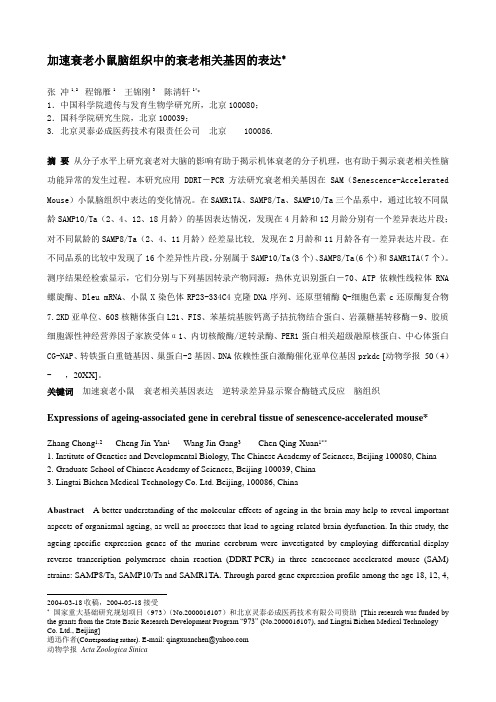
加速衰老小鼠脑组织中的衰老相关基因的表达*张冲1,2 程锦雁1王锦刚3 陈清轩1**1.中国科学院遗传与发育生物学研究所,北京100080;2.国科学院研究生院,北京100039;3. 北京灵泰必成医药技术有限责任公司北京100086.摘要从分子水平上研究衰老对大脑的影响有助于揭示机体衰老的分子机理,也有助于揭示衰老相关性脑功能异常的发生过程。
本研究应用DDRT-PCR方法研究衰老相关基因在SAM(Senescence-Accelerated Mouse)小鼠脑组织中表达的变化情况。
在SAMR1TA、SAMP8/Ta、SAMP10/Ta三个品系中,通过比较不同鼠龄SAMP10/Ta(2、4、12、18月龄)的基因表达情况,发现在4月龄和12月龄分别有一个差异表达片段;对不同鼠龄的SAMP8/Ta(2、4、11月龄)经差显比较, 发现在2月龄和11月龄各有一差异表达片段。
在不同品系的比较中发现了16个差异性片段,分别属于SAMP10/Ta(3个)、SAMP8/Ta(6个)和SAMR1TA(7个)。
测序结果经检索显示,它们分别与下列基因转录产物同源:热休克识别蛋白-70、ATP依赖性线粒体RNA 螺旋酶、Dleu mRNA、小鼠X染色体RP23-334C4克隆DNA序列、还原型辅酶Q-细胞色素c还原酶复合物7.2KD亚单位、60S核糖体蛋白L21、FIS、苯基烷基胺钙离子拮抗物结合蛋白、岩藻糖基转移酶-9、胶质细胞源性神经营养因子家族受体α1、内切核酸酶/逆转录酶、PER1蛋白相关超级融原核蛋白、中心体蛋白CG-NAP、转铁蛋白重链基因、巢蛋白-2基因、DNA依赖性蛋白激酶催化亚单位基因prkdc [动物学报50(4)-,20XX]。
关键词加速衰老小鼠衰老相关基因表达逆转录差异显示聚合酶链式反应脑组织Expressions of ageing-associated gene in cerebral tissue of senescence-accelerated mouse*Zhang Chong1.2Cheng Jin-Yan1Wang Jin-Gang3Chen Qing-Xuan1**1. Institute of Genetics and Developmental Biology, The Chinese Academy of Sciences, Beijing 100080, China2. Graduate School of Chinese Academy of Sciences, Beijing 100039, China3. Lingtai Bichen Medical Technology Co. Ltd. Beijing, 100086, ChinaAbastract A better understanding of the molecular effects of ageing in the brain may help to reveal important aspects of organismal ageing, as well as processes that lead to ageing-related brain dysfunction. In this study, the ageing-specific expression genes of the murine cerebrum were investigated by employing differential-display reverse transcription polymerase chain reaction (DDRT-PCR) in three senescence-accelerated mouse (SAM) strains: SAMP8/Ta, SAMP10/Ta and SAMR1TA. Through pared gene expression profile among the age 18, 12, 4,2004-03-18收稿,2004-05-18接受*国家重大基础研究规划项目(973)(No.2000016107)和北京灵泰必成医药技术有限公司资助[This research was funded by the grants from the State Basic Research Development Program “973” (No.2000016107), and Lingtai Bichen Medical Technology Co. Ltd., Beijing]通迅作者(Co rresponding author). E-mail: qingxuanchen@动物学报Acta Zoologica Sinicaand 2 month of the SAMP10/Ta strain, two differential fragments have been found, which belong to 4 and 12 month individually; and in age 11, 4 and 2 month of the SAMP8/Ta strain, two fragments have been found, which belong to 11 and 2 month respectively. And pared gene expression profile in different strains mice, 16 fragments have been detected, 3, 6 and 7 of them belong to SAMP10/Ta, SAMP8/Ta and SAMR1TA respectively. Sequence results indicate that those fragments are homologous with heat shock protein cognate protein 70,ATP-dependent mitochondrial RNA helicase, Dleu2 mRNA, Mouse DNA sequence from clone RP23-334C3 on chromosome X, ubiquinol-cytochrome c reductase plex (7.2 kD), 60S ribosomal protein L21, FIS, phenylalkylamine Ca2+ antagonist (emopamil) binding protein, fucosyltransferase 9, glial cell line derived neurotrophic factor family receptor alpha 1, endonuclease/reverse transcriptase, PER1 interacting protein of the suprachiamatic nucleus homolog, centrosomal protein CG-NAP, ferritin heavy chain gene, NID-2 gene, and prkdc gene for DNA-dependent protein kinase catalytic subunit [Acta Zoologica Sinica 50(4): -, 20XX].Key words Senescence-Accelerated Mouse, Ageing-associated gene expression, Differential display reverse transcription polymerase chain reaction; Cerebral Tissue衰老是指机体达到其最大繁殖能力后生理功能的进行性降低(Roy et al., 1996),是一个自发而又与早期的程序化发育相对应的过程。
生物信息学-欢迎光临浙江大学生命科学学院

FTP
Bill Gates和Paul Allen成立微软; Bill Joy developed C
shell (csh) and Vi text editor David Boggs invent Ethernet; Stephen Wozniak et al found Apple
算(manuipulation),分析(analysis),模拟 (simulation),预测(prediction)等等的一门新兴学科,
是21世纪科学发展的热点之一。
Biology, Bioinformatics, Systems Biology
3
Genetics & Genomics
4
Genomic achievements since HGP
Apple introduce macintosh System 3.0
Larry Wall推出Perl语言
Apple introduce macintosh System 4.0; Windows 2.0
Compact Disk Recordable (CD-R); Pearson实现FASTA程序
Arpanet ceases to exist (INTERNET). Archie by Alan Emtage created.
Gopher by Paul Lindner. Python by Guido van Rossum; Tim BernersLee announce the WWW project; Linus Torvalds releases Linux versions 0.01.
高三英语生物英语阅读理解30题
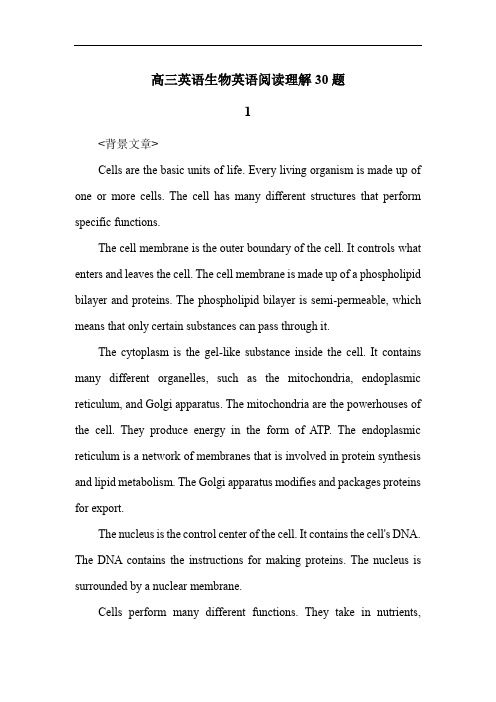
高三英语生物英语阅读理解30题1<背景文章>Cells are the basic units of life. Every living organism is made up of one or more cells. The cell has many different structures that perform specific functions.The cell membrane is the outer boundary of the cell. It controls what enters and leaves the cell. The cell membrane is made up of a phospholipid bilayer and proteins. The phospholipid bilayer is semi-permeable, which means that only certain substances can pass through it.The cytoplasm is the gel-like substance inside the cell. It contains many different organelles, such as the mitochondria, endoplasmic reticulum, and Golgi apparatus. The mitochondria are the powerhouses of the cell. They produce energy in the form of ATP. The endoplasmic reticulum is a network of membranes that is involved in protein synthesis and lipid metabolism. The Golgi apparatus modifies and packages proteins for export.The nucleus is the control center of the cell. It contains the cell's DNA. The DNA contains the instructions for making proteins. The nucleus is surrounded by a nuclear membrane.Cells perform many different functions. They take in nutrients,produce energy, and get rid of waste. They also grow, divide, and respond to their environment.1. What is the outer boundary of the cell?A. The cytoplasmB. The nucleusC. The cell membraneD. The mitochondria答案:C。
序列搜索_比对以及进化树的构建

Clustalx的输出结果
• .aln格式文件
– 这个文件是默认输出,可以转换成各种格式, 而且很多软件都支持这种格式。
• .dnd格式文件
– 引导树。就是根据两两序列相似值构建的一个 指导后面多重联配的启发树 – 不能做进化分析。进化分析要考虑的所有同源 位点的一个综合效应,因此应该用.aln格式文 件专门做进化分析。
• Blastn : 应该是出现较早的算法。比对的速度慢, 但允许更短序列的比对(如短到7个碱基的序列)。 • MEGABLAST : 主要用来鉴定一段新的核酸序列, 它并不注重比对各个碱基的不同和序列片断的同 源性,而只注重被比对序列是否是数据库未收录 的,是否为新的提交序列或基因。 速度快。同一 物种间的。 • Discontiguous MEGABLAST : 灵敏度 (sensitivity)更高,用于更精确的比对。主要用 于跨物种之间的同源比对。
• dnadist 计算核苷酸距离矩阵 • 把刚才的outfile改名,如dnadistinfile • 双击dnadist,输入dnadistinfile,回车
输入D,选择模型, 如改成kimura-2 输入M,然后输入 D,再输入1000, 和上面步骤要一致 即自举值 bootstrap=1000
• NCBI负责管理GenBank。 GenBank是
美国国立卫生研究院维护的基因序列数据库, 汇集并注释了所有公开的核酸序列。
• GenBank与日本DNA数据库(DNA Data Bank of Japan, DDBJ)以及欧洲生物信息研究所的欧洲 分子生物学实验室核苷酸数据库(European Molecular Biology Laboratory, EMBL),所有这 3个中心都可以独立地接受数据提交,而3个中心 之间则逐日交换信息,并制成相同的充分详细的 数据库向公众开放。因此他们是相等的。
基于西藏地区饮食特点的糖尿病膳食指导

西藏医药2020年第41卷第6期(总153期)•讲座•综述•基于西藏地区饮食特点的糖尿病膳食指导沈晶西藏自治区人民医院内分泌科西藏拉萨850000摘要随着人们生活水平的不断提高,糖尿病的患病率也逐年增高,饮食治疗是糖尿病的基础治疗手段之一,合理的膳食对于血糖的控制起着至关重要的作用。
西藏地区的饮食特点较为独特,本文就西藏地区的饮食特点,结合中国糖尿病营养治疗指南,进一步探索适合西藏地区糖尿病患者的饮食指导。
关键词西藏糖尿病膳食糖尿病是由多种病因引起的代谢紊乱。
近30多年来,我国成年糖尿病患病率显著升高,2013年成年糖尿病患病率达10.9%[1]。
目前,糖尿病成为继心脑血管疾病和肿瘤之后第3位危害人类生命和健康的慢性非传染性疾病[2]。
西藏地区流行病学调查显示:当地藏族居民糖尿病患病率为3.24%[3],虽然远低于全国的患病率,但多数居民对该病的知晓率、重视程度及认知水平均较低[4叫以致当地居民长期的血糖控制欠佳。
饮食治疗是糖尿病的基础治疗手段之一,合理膳食指导对于血糖的有效控制起着至关重要的作用。
西藏独特的地理环境使广大藏区居民形成了独特的饮食习惯。
本研究综述西藏地区饮食特点,结合中国糖尿病营养治疗指南,进一步探索适合西藏当地糖尿病患者的饮食指导,帮助病人更好地控制血糖水平,防止或延缓糖尿病相关并发症的发生和发展。
1西藏地区饮食习惯中存在的营养问题西藏地处高原,当地居民为适应环境,形成了有别于其他民族的膳食习惯。
从膳食结构来看,多项研究显示当地居民膳食种类缺乏多样性,糌耙做为当地居民的主要食物,而肉类和奶类次之,其它食物种类中,如蛋类、猪肉、禽肉、豆制品、水果、蔬菜等需求明显不足,这是导致居民膳食结构不均衡的主要原因[6-8],且与西藏高海拔地区不适合植被的生长以及当地的宗教文化有关。
从营养结构来看,当地居民每日能量摄入基本满足膳食营养素参考摄入量标准[6,9],但三大营养素占比不合理。
首先,脂肪摄入量明显超出了供给量标准,其中动物性油脂是当地居民脂肪的主要来源[9,10],而酥油作为当地独具特色的食物消费种类,是当地动物性脂肪的主要来源。
〖医学〗基因直接进化研究进展——DNA Shuffling技术

Martin Lehmann等(2000~2002)把这种方法应 用在真菌植酸酶家族设计合成了同序植酸酶基因, 并表达出具热稳定性的同序植酸酶。
真菌植酸酶aa序列的同序比较
同序植酸酶-1的最适温度为71℃,而亲代植酸酶的最适温 度为45-55℃,增加了16-26℃, 同序植酸酶-1Tm为78℃,比亲代 植酸酶增加了15-22℃,而催化性质与大多数亲本植酸酶相似。
基因直接进化研究进展
——DNA Shuffling技术
四川农业大学
生物的自然进化
➢进化过程:
突变→自然选择→遗传后代
➢进化结果:
基因多样性:为完成同一功能所表现出的 多个 基因或同一个基因(同源性)
代谢途径的多样性:同样产物,多条途径 代谢产物的多样性:同一底物,不同产物 生物多样性:整个生态系统中的生物
人工获取新基因的方法
➢常规的基因工程方法
生物功能 蛋白质 基因
➢新基因的理性设计和人工合成
根据已有基因的序列和功能进行设计
➢基因的直接进化(directed evolution)
可使已有基因获得新的特性 可获得自然界中不存在的基因 可解决许多新的理论和应用问题
基因直接进化的用途
提高酶活性——天门冬氨酸氨基转移酶活性
Nature Biotechnology Vol. 17, August, 1999
Aims of the work: Demonstration of usefulness of the DNA shuffling tool for rapidly evolving human a interferon towards improving antiviral property
英语生物分类学测试40题

英语生物分类学测试40题1. Which of the following is a mammal?A. BirdB. SnakeC. DogD. Fish答案:C。
狗是哺乳动物,具有哺乳动物的特征,如胎生、哺乳等。
选项 A 鸟属于鸟类,选项B 蛇属于爬行动物,选项D 鱼属于鱼类。
2. Insects belong to which phylum?A. ChordataB. ArthropodaC. MolluscaD. Echinodermata答案:B。
昆虫属于节肢动物门(Arthropoda),节肢动物具有分节的附肢等特征。
选项 A 脊索动物门包括脊椎动物,选项C 软体动物门如蜗牛等,选项D 棘皮动物门如海星等。
3. Which of the following is an amphibian?A. FrogB. LizardC. RabbitD. Tiger答案:A。
青蛙是两栖动物,其生活史包括水生和陆生阶段。
选项B 蜥蜴是爬行动物,选项C 兔子是哺乳动物,选项D 老虎是哺乳动物。
4. Plants are classified into different groups based on:A. Their sizeB. Their colorC. Their structure and reproduction methodsD. Their smell答案:C。
植物根据其结构和繁殖方式进行分类。
选项A 大小不是主要分类依据,选项B 颜色也不是,选项D 气味同样不是。
5. Which of the following is a reptile?A. TurtleB. DuckC. CatD. Bee答案:A。
乌龟是爬行动物,具有爬行动物的特征。
选项B 鸭子是鸟类,选项C 猫是哺乳动物,选项D 蜜蜂是昆虫。
6.Which of the following animals is a mammal?A. SnakeB. FrogC. DogD. Bird答案:C。
矿产
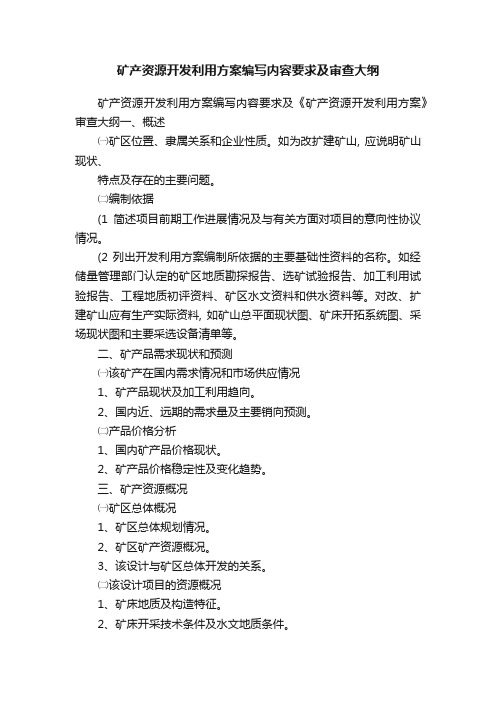
矿产资源开发利用方案编写内容要求及审查大纲
矿产资源开发利用方案编写内容要求及《矿产资源开发利用方案》审查大纲一、概述
㈠矿区位置、隶属关系和企业性质。
如为改扩建矿山, 应说明矿山现状、
特点及存在的主要问题。
㈡编制依据
(1简述项目前期工作进展情况及与有关方面对项目的意向性协议情况。
(2 列出开发利用方案编制所依据的主要基础性资料的名称。
如经储量管理部门认定的矿区地质勘探报告、选矿试验报告、加工利用试验报告、工程地质初评资料、矿区水文资料和供水资料等。
对改、扩建矿山应有生产实际资料, 如矿山总平面现状图、矿床开拓系统图、采场现状图和主要采选设备清单等。
二、矿产品需求现状和预测
㈠该矿产在国内需求情况和市场供应情况
1、矿产品现状及加工利用趋向。
2、国内近、远期的需求量及主要销向预测。
㈡产品价格分析
1、国内矿产品价格现状。
2、矿产品价格稳定性及变化趋势。
三、矿产资源概况
㈠矿区总体概况
1、矿区总体规划情况。
2、矿区矿产资源概况。
3、该设计与矿区总体开发的关系。
㈡该设计项目的资源概况
1、矿床地质及构造特征。
2、矿床开采技术条件及水文地质条件。
- 1、下载文档前请自行甄别文档内容的完整性,平台不提供额外的编辑、内容补充、找答案等附加服务。
- 2、"仅部分预览"的文档,不可在线预览部分如存在完整性等问题,可反馈申请退款(可完整预览的文档不适用该条件!)。
- 3、如文档侵犯您的权益,请联系客服反馈,我们会尽快为您处理(人工客服工作时间:9:00-18:30)。
萨德伯里的陨石冲击,约18.5亿年
SUDBURY BRECCIA
萨德伯里角砾岩
Large vein of partial melt with blocks of granite gneiss
块状花岗质片麻岩的部分熔融 形成的大脉体
些过 成程
Immiscible sulfide droplets segregated from the impact melt during due to super cooling settle into the embayment 小滴的不混溶硫化物在冲击熔融中分凝,在 特别冷的时候沉淀到港湾中
This model suggests that magmatic Ni-Cu sulfide deposits occur in the base of large layered intrusions. It was regarded as an universal model in many textbooks and widely used in mineral exploration worldwide until recently. 这种模式提出了岩浆硫化物矿床产于大规模的侵入体中。在许多教科书中它已经被认为是个普 遍的模式,并且直到现今在矿产勘探中已被广泛的使用。
Controls on S solubility at sulfide saturation (硫在饱和硫化物中溶解度的控制因素)
Temperature(温度):
Positive(正相关)
FeO content( FeO含量): Positive(正相关)
Pressure(压力):
Negative(负相关)
(2) Fluid or vapor transportation of S released from footwall(下盘释放出的硫 在流体和蒸汽中的运移)
How does mantle peridotite melt?
(地幔橄榄岩是怎样融化的)
@ N. Arndt
In peridotites, PGE, Cu and Au are mainly in small sulfide or alloy grains; Ni is partitioned between sulfide-alloy and olivine(橄榄岩 中,PGE,铜和金主要存在于小的硫化物或细粒合成硫化物中;镍被分 隔在合成硫化物和橄榄石之间)
ln XS = a + b(104/T) + c P + ΣdiXi
Coefficient (系数)
a b c d XSiO2 d XMgO d XFeO
Value (数值) 0.944 -0.579 -0.024 -5.58 -1.378 2.617
Std. Error (标准误差) 0.453 0.048 0.002 0.341 0.406 0.681
Shocked Quartz from Onaping பைடு நூலகம்ormation
Onaping组中的冲击成因石英
Shatter Cones south of Kelley Lake
Kelley Lake南部冲击锥体
片麻岩 下盘角砾岩 亚层 浅色苏长岩 硫化物矿石
Mineralised Sublayer norite with olivine melanorite inclusion: Whistle Mine
经过几十年在大型层状侵入体中对萨德伯里型铜镍硫化物 矿床的探索,尽管没有成功,但最终我们意识到已经被萨 德伯里模式愚弄了很长时间。SIC是一个硫化物饱和的冲 击熔融岩席在过冷时形成的,不是在大陆岩浆作用过程中 的岩浆系统中发生的。
Genesis of Ni-Cu Sulfide Deposits Associated with Continental Magmatism
非常重要的必备条件 (1)富铜和镍的岩浆 (2)在地壳水平时硫化物饱和 (3)在限定的地点的硫化物液体的浓缩
THEORIES(理论)
(1) Controls on S solubility at sulfide saturation(硫在饱和硫化物中溶解 度的控制因素)
(2) Genesis of fertile magma(富矿岩 浆的起源)
10% partial melting
(10%部分熔融)
@ N. Arndt
At ~10% melting, PGE, Au and Cu remain in sulfides; Ni is partitioned between sulfide and silicate phases; the melt is poor in Ni and PGE (10%熔融状态下,PGE、金和铜仍然在硫化物中;镍位于硫化物和硅酸 盐相之间;镍和PGE中的熔融很微弱)
Acknowledgement: Some slides used in this presentation are from Tony Naldrett and Peter Lightfoot
致谢:本次讲解所用幻灯片部分由Tony Naldrett和Peter Lightfoot提供
世界级岩浆硫化物矿床
Kambalda,Raglan) 2.Related to Continental Flood Basalts (principal example-
Noril’sk, but also Duluth,Insizwa) 3.Related to Ferropicrites (principal example Pechenga) 4.Anorthosite plutonic suites (principal example-Voisey’s Bay) 5.Picrite-tholeiite magmas (principal example Jinchuan) 6.Impact melt (ONLY example-Sudbury)
Evolution of Genetic Models for Magmatic Ni-Cu Sulfide Deposit
岩浆硫化物矿床成因模式的演化
Chusi Li
Indiana University China University of Geosciences-Beijing
李楚思
印地安那大学,中国地质大学(北京)
镍矿床
铂族矿床
Merensky Reef
镍矿产量+资源量(百万吨)
镍 的 品 位 用 百 分 比 表 示
铜-镍矿床
铂族元素矿床After Naldrett
Magmatic Associations of Ni-Cu deposits 1.Related to Komatiites (ultramafic lavas-principal example-
Ni-Cu矿床岩浆组合 1.与科马提岩相关(主要为超基性熔岩,实例-Kambalda,Raglan) 2.与大陆溢流玄武岩相关(主要的实例-Noril’sk,以及Duluth,Insizwa) 3.与铁苦橄岩相关(主要的实例-Pechenga) 4.斜长岩侵入体组合(主要的实例-Voisey’s Bay) 5.橄榄岩-拉斑玄武岩岩浆(主要的实例为金川) 6.冲击熔融(仅有的实例-Sudbury)
r2 = 0.91, n = 159
S solubility limit
Causes of Sulfide Saturation
(饱和硫化物的形成原因) • Super cooling(过度冷却) • Fractional crystallization(分馏结晶) • Magma mixing(岩浆混合) • Assimilation of felsic crust(长英质地
基性岩浆的对流
亚层中的基性或超基性包体
下盘角砾岩
下盘角砾岩是部分熔融形成的冲击角砾岩,这些砾岩在上覆岩石冲 击熔融时,没有被改造而得以保留。
A Wake-up Call
一个突然的醒悟
After several decades of unsuccessful hunt for the Sudbury type Ni-Cu deposits in large layered intrusions, we finally come to realize that we have been fooled for too long by the Sudbury model. The SIC is a meteorite impact melt sheet in which sulfide saturation was induced by super-cooling that does not occur in magmatic systems of continental magmatism.
(3) Fe-Ni-Cu-S phase relations(铁-镍铜-硫的相位关系)
(4) Ni, Cu, PGE partitioning(镍,铜, PGE分区)
Chusi Li
Indiana University, Bloomington China University of Geosciences, Beijing
壳的同化作用) • Addition of crustal S(地壳硫含量增
加)
Silicate/Sulfide Ratio
Addition of Crustal Sulfur
(地壳中硫含量的增加)
(1) Selective assimilation of S-bearing phases in country rocks(围岩中含硫相 的选择性同化作用)
